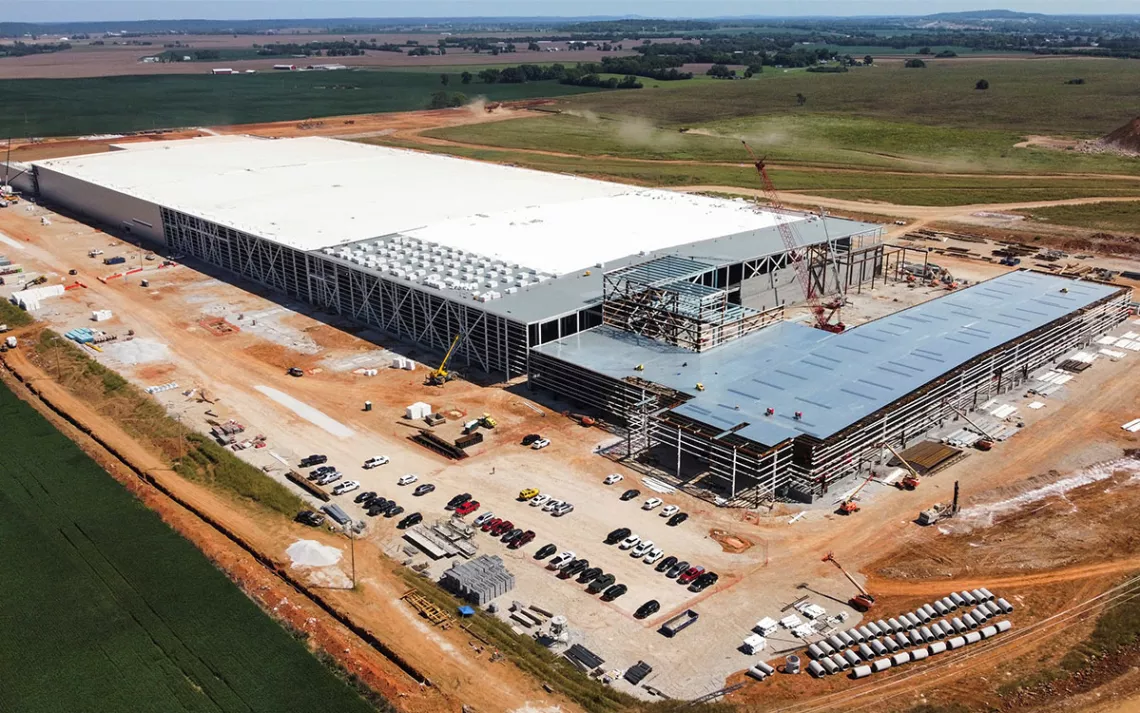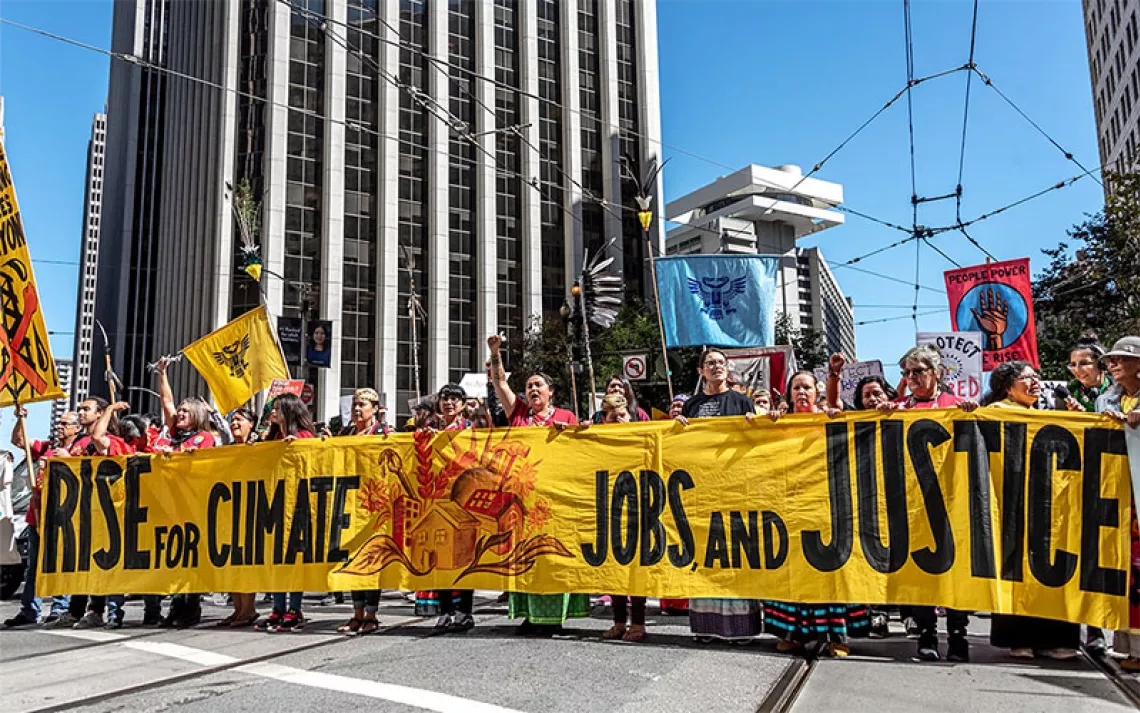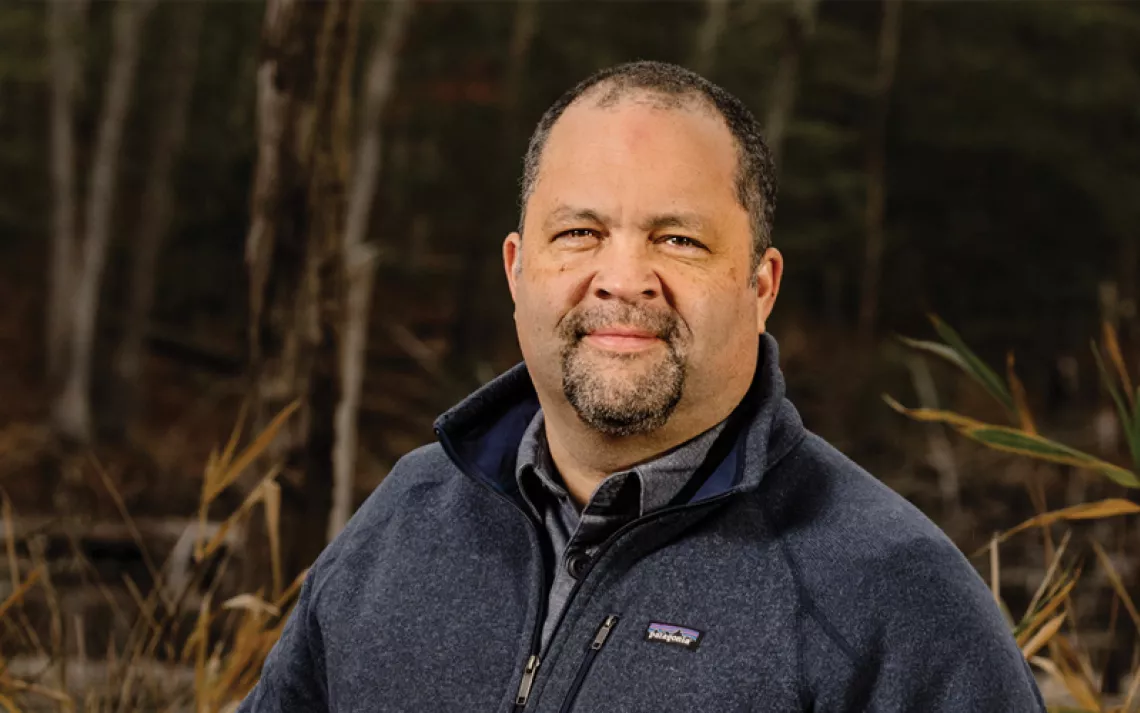Clean Energy Jobs, and Unionization, Are Moving Into the South
The UAW’s recent strike could mark a turning point

Construction resumes on the 1.6 million square foot AESC gigafactory being built in the Kentucky Transpark in Bowling Green. | Photo by Grace Ramey/Daily News via AP
In Kentucky last month, Governor Andy Beshear celebrated the news that Ford Motor Company will soon be building a new electric vehicle model at the Louisville Assembly Plant, one of the state’s biggest employers. The announcement came after the conclusion of the historic strike by the United Auto Workers, just the latest in a string of work stoppages this year that have stretched from Hollywood writers’ rooms to local Starbucks. Known as the “Stand Up Strike,” the UAW’s six-week action against the Big Three US auto manufacturers—General Motors, Ford, and Stellantis (formerly Chrysler)—hinged on the questions of whether and to what degree EV manufacturing jobs would be covered by traditional union agreements.
The tentative agreement still needs to be ratified by UAW members—which is far from a done deal, as many plants have voted down the agreement. Nevertheless, the new contract negotiated between the UAW leadership and the Big Three highlights a historic convergence between the labor movement and the environmental movement. For years, environmental groups and unions have been trumpeting the idea of a “just transition” in which good-paying, union jobs would form the backbone of the green economy. Now, workers and unions are fighting to make that vision a reality, and it’s happening in what might seem an unlikely location—the American South.
In 2022, Kentucky had the nation’s second-highest growth in clean energy jobs, according to a report released in September. Tennessee, which came in first, added more than 5,000 new clean energy jobs last year. In the last year, Georgia has attracted more clean energy manufacturing investment than any other state, and projections show that those investments could lead to more than 11,000 new jobs in the year to come. South Carolina isn’t far behind.
“Most of the Southeast is exploding, especially in clean vehicles and battery technology,” said Michael Timberlake, communications director of E2, a nonpartisan group advocating for economic and environmental policies. Timberlake, who authored the recent report on clean energy jobs, said the region was “leading the nation” in large-scale clean energy projects.
Clean energy companies now employ almost half of all new energy workers, and more than 3.3 million people nationwide. The job boom barely accounts for the ballooning benefits of the Inflation Reduction Act, which was passed in August 2022. Since then, at least 210 major new clean energy and clean vehicle projects have been announced in the United States, creating more than 74,000 jobs and securing over $86 billion in private investments.
“We know we can’t leave workers behind,” said Holly Burke, communications director of Evergreen Action, an advocacy group promoting climate action. “An economic transition that leaves workers behind is not going to be politically popular, and we need to make sure workers can reap the benefits of the new future that they’re building.”
The tentative agreement between the American automakers and the UAW is an example of how to ensure the benefits of the energy transition are spread widely. When the Big Three began siting and constructing new battery plants, the facilities were often joint ventures with other companies. Auto manufacturers originally said those joint businesses didn’t fall under the existing UAW contracts. After 44 days on the picket line, the UAW is now negotiating the inclusion of electric vehicle battery and manufacturing jobs in traditional UAW agreements at 10 current or planned facilities, nine of which are joint ventures.
That’s a big deal for a state like Kentucky, where Governor Beshear is working to establish the commonwealth as the country’s production capital of electric vehicle batteries in the newly nicknamed Battery Belt, a smattering of under-construction facilities concentrated in the Southeast. In 2022, Beshear announced Kentucky’s largest ever economic development project—the BlueOval SK Battery Park, partially owned by Ford Motor Company, that eventually will provide 5,000 jobs. Battery production careers could soon be almost double the 4,631 coal jobs left in the state.
The greater South has long been a hub for automakers, partly due to cheap land costs, good ports and highways systems, the availability of skilled labor even in states that discourage unionization, and efforts by local leaders to attract new jobs and new opportunities. “Naturally they have been one of the most attractive regions for automakers and their suppliers looking to invest in and build out clean vehicle manufacturing capacities,” Timberlake said. “This is the base from where the Inflation Reduction Act will do a launching off. There’s a lot more growth to come.”
Tennessee, for example, has secured $7 billion in 14 new clean energy projects since the IRA passed. Those projects are expected to create more than 5,600 new jobs not included in the September report. Clean energy now accounts for more than a third of all new jobs announced last year in the Volunteer State.
While the clean energy sector has exploded across the nation, the majority of new jobs in the last year are in largely Republican communities. Red states like Kentucky and Tennessee have cornered the market for clean energy job growth, according to E2’s August report, with about 72 percent of all jobs and 86 percent of announcements in Republican districts.
In the Republican stronghold of Middle Tennessee, a surge of clean energy jobs and facilities have landed the state’s 7th Congressional District in the nation’s top 10 districts for clean energy investments. According to the August report by E2, the region is welcoming three projects providing $3.2 billion in economic investment and over 1,000 jobs. The district is represented in Congress by Republican Mark E. Green, a staunch climate denier with a 1 percent lifetime score from the League of Conservation Voters. The BlueOval SK Battery Park is located in Kentucky’s 2nd Congressional District, home to Representative Brett Guthrie, a Republican who has a 6 percent lifetime score from the League of Conservation Voters. Half of the top 10 districts are in the Southeast, according to the report, providing over 11,000 jobs in districts that are solidly Republican.
“Republicans are happy to have clean energy investments … because these are good family-sustaining jobs that people are excited to get,” said Burke, who added Republicans voted at least 25 times to repeal the IRA. “It’s an obvious moment of hypocrisy.”
But once the battery plants are built, Burke said, providing jobs for thousands of people across their districts, “it becomes much more politically tricky for Republicans to stab their own constituents in the back.” Climate action advocates hope that, in the long run, the growth of clean energy jobs in Republican districts will create a bipartisan constituency for the renewable energy economy.
Over 96,000 electric vehicle manufacturing jobs have been created in just five Southern states: Georgia, Tennessee, South Carolina, North Carolina, and Kentucky. Those five states also have something else in common: They are all right-to-work states.
In the mid-20th century, over a dozen states—including Georgia, North Carolina, and South Carolina—became right-to-work states, meaning workers cannot be compelled to join a union to get or keep a job. Right-to-work laws are often viewed as a way to weaken worker protections, and such laws are growing in number. In 2017, Kentucky became a right-to-work state, followed by Tennessee’s right-to-work constitutional amendment in 2022.
Ariana Levinson, a labor and employment law scholar at the University of Louisville, said while the South has traditionally been a right-to-work region, border states like Kentucky and midwestern states like Indiana are relatively recent adopters. Passing right-to-work laws serves as a signal to employers looking to locate their businesses to a region with employer-friendly laws. Generally, right-to-work laws tend to undermine unionization and higher wages, Levinson added.
“The South has a good workforce, and it has a lot of support for various economic growth initiatives. And it’s likely cheaper for them to set up shop in places in the Southeast that are not unionized,” said Mark Curtis, an economics and labor professor at Wake Forest University.
“One of the best things that could happen as a result of the negotiations right now with Ford, or existing companies that will be shareholders in EV battery plants, is they are able to negotiate neutrality clauses,” said Levinson. That means an employer, like Ford, has committed to not campaigning against the UAW if non-unionized workers decide to organize. The neutrality clause is a big reason why the strike was drawn out, according to Levinson.
Without such a clause, a state like Kentucky could also encourage unionization by repealing its right-to-work law, as Michigan did earlier this year, making it the first state to repeal a right-to-work law in 58 years. The turnaround was quick: Michigan established its right-to-work law in 2012 under a GOP-legislature and amid protests at the state capital. In signing the repeal, Governor Gretchen Whitmer, a Democrat, said in a statement that the move was to “restore workers’ rights.”
For Timberlake, the growth of green jobs shows that clean energy and clean vehicle jobs aren’t just for right-to-work states or union states, Democratic or Republican states. “These are good-paying jobs that are available in all states, for all Americans.”
Then this week, after a 47 percent voter turnout, members of Louisville’s 12,000 Ford workers voted against the tentative agreement, which included a 25 percent wage increase but failed to bring back employee pensions and retiree health care. The Kentucky Truck Plant and Louisville Assembly Plant, represented by UAW Local 862, has a history of voting down agreements, failing to approve tentative ones in 2019, 2015, and 2011, according to the Courier Journal.
But unlike Louisville, two other Ford plants in Michigan and Chicago voted to pass the contract. A majority of workers at each of the Big Three have to vote to ratify the contracts for them to take effect. Todd Dunn, UAW Local 862 president, told the Courier Journal he believes the contracts will be ratified after national results are received by the end of the week. If the contracts fail to get a majority yes vote, negotiators would have to return to bargaining.
 The Magazine of The Sierra Club
The Magazine of The Sierra Club



